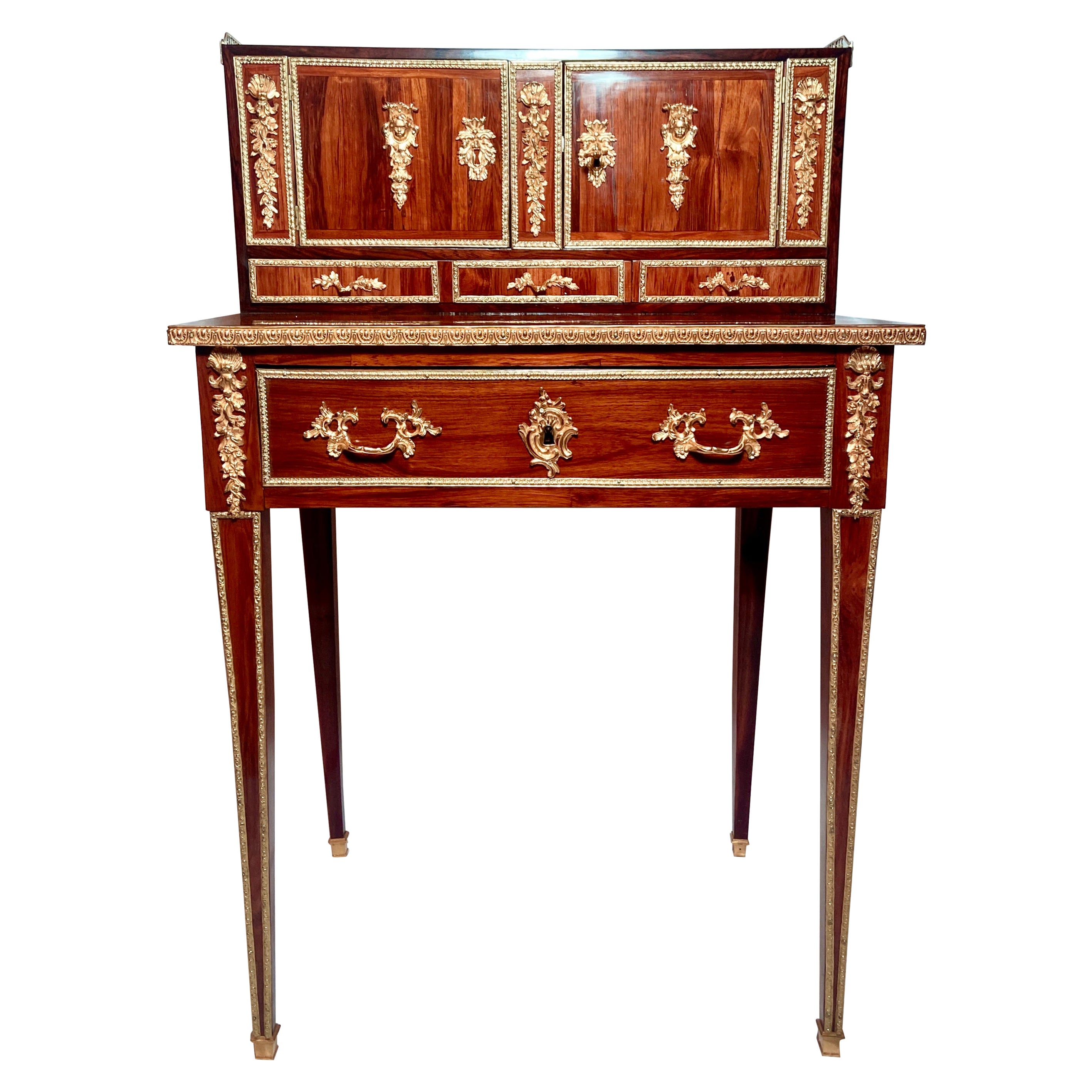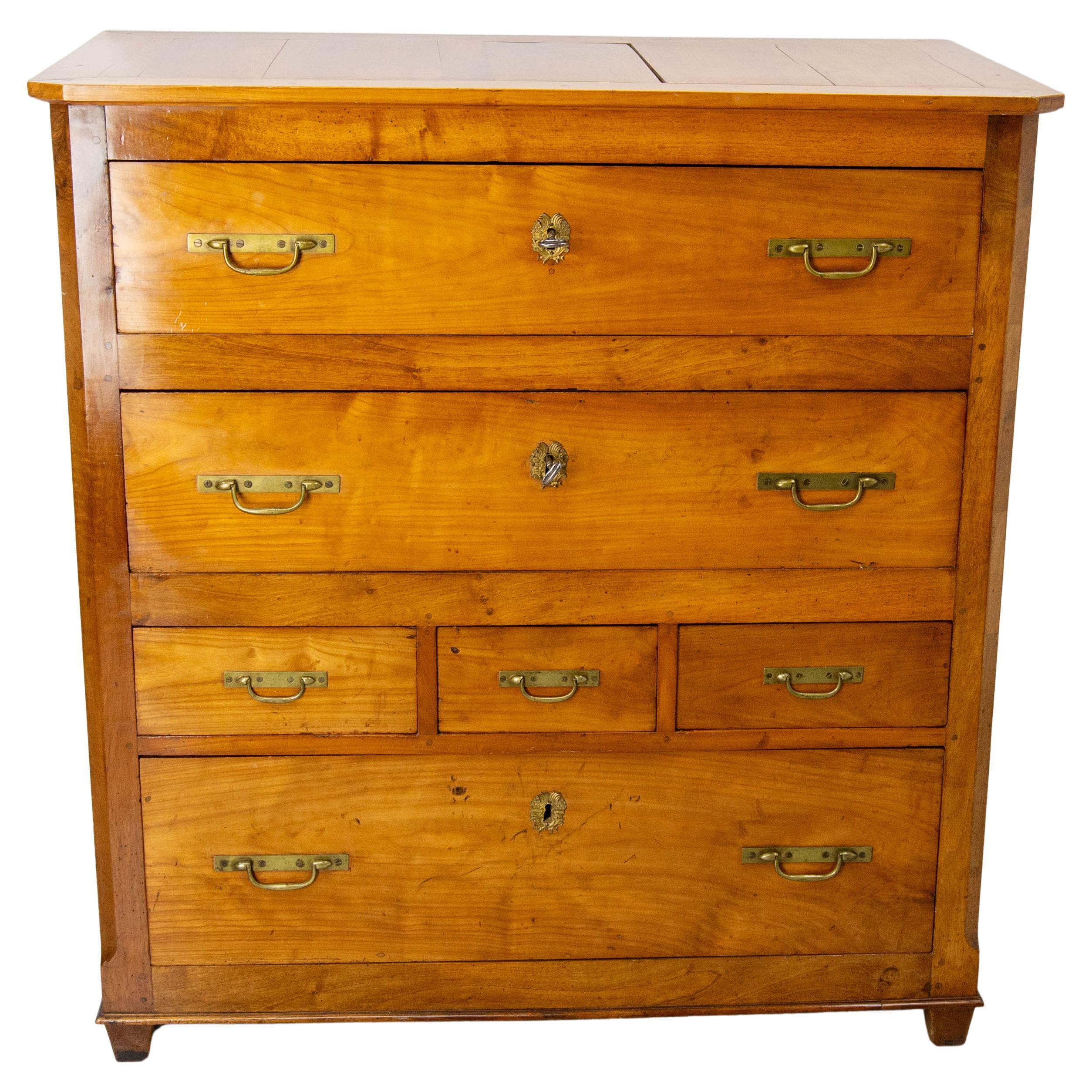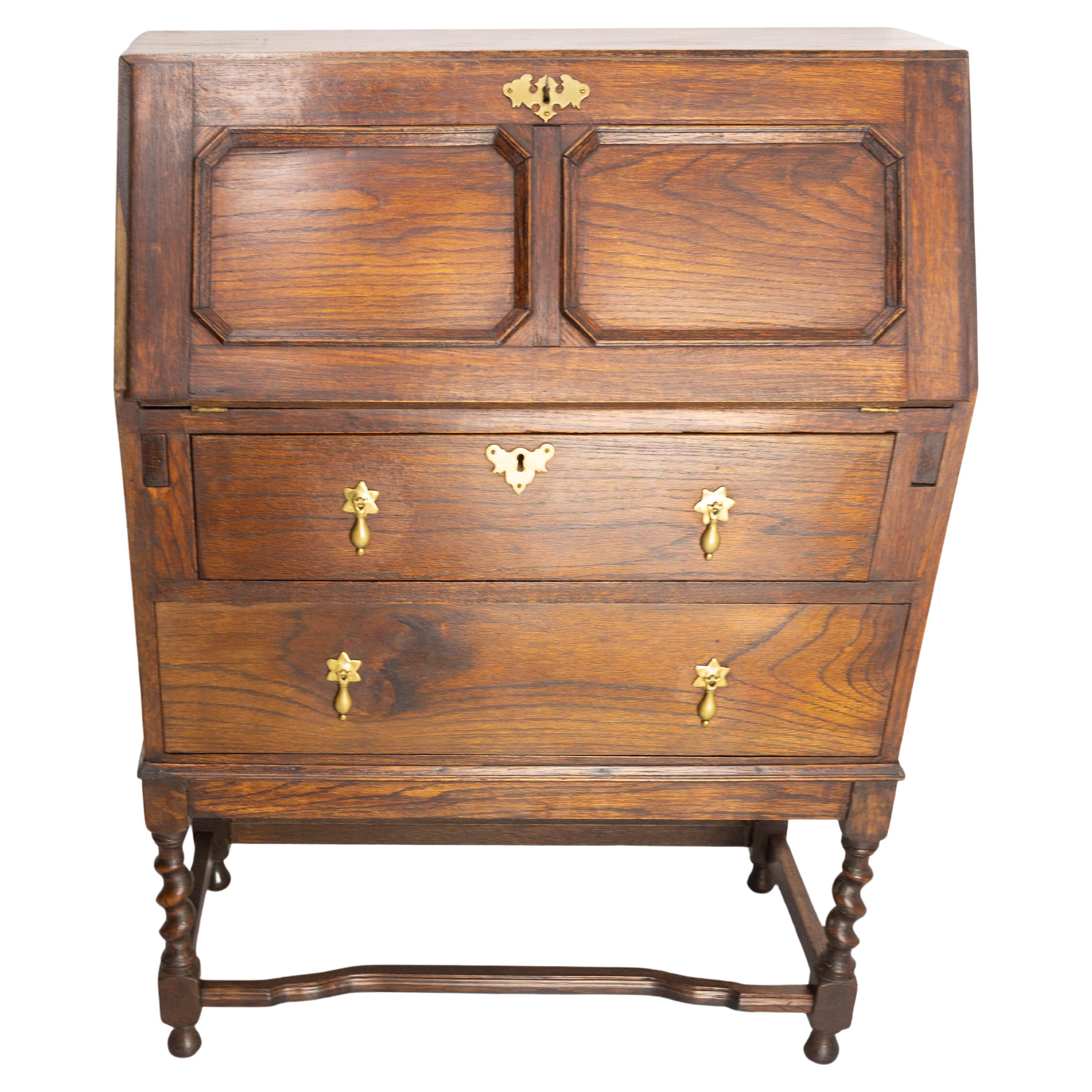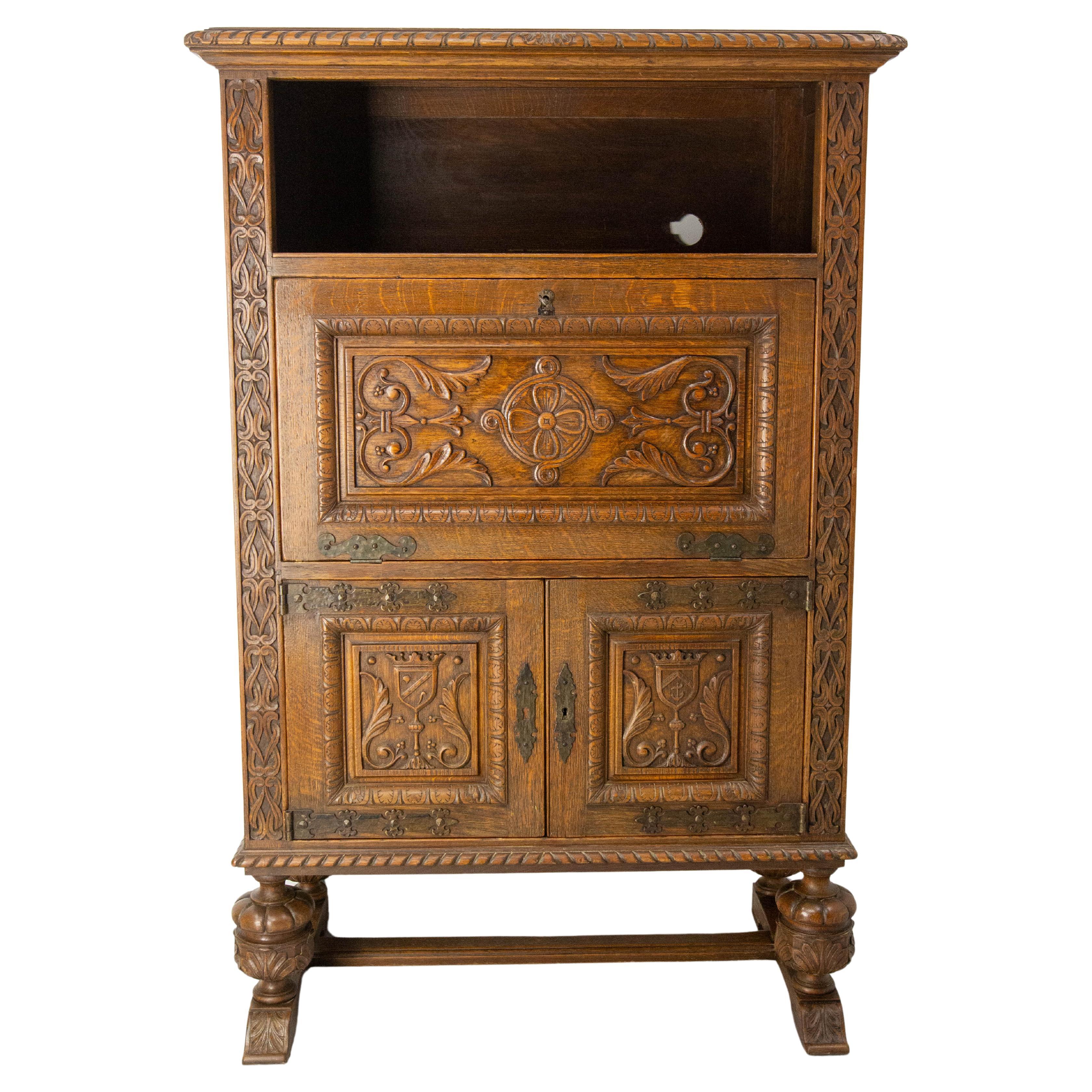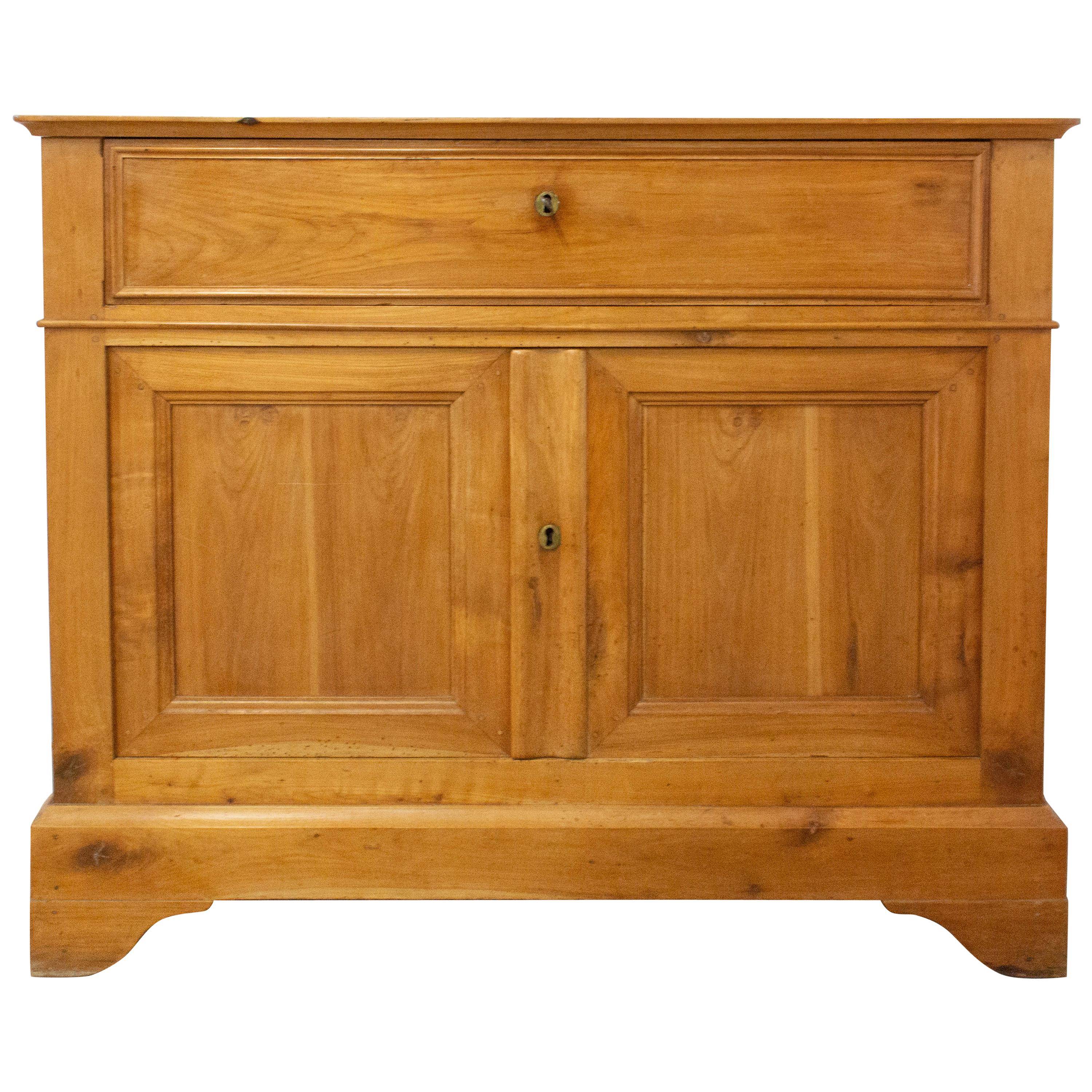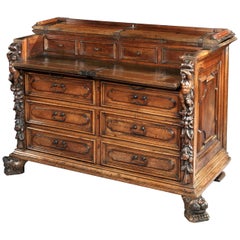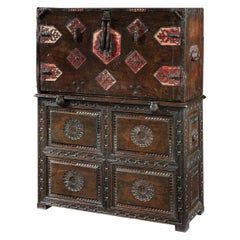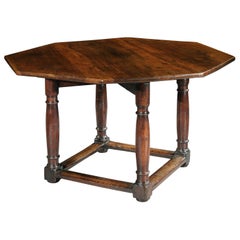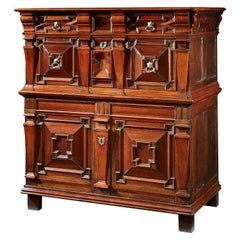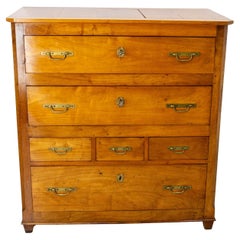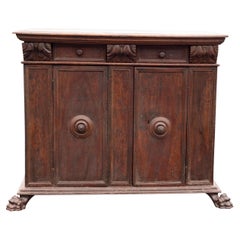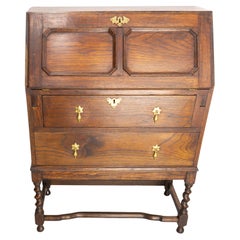Items Similar to Writing Cabinet Scrittoio Escritoire Desk Walnut Italy Florence Renaissance
Want more images or videos?
Request additional images or videos from the seller
1 of 17
Writing Cabinet Scrittoio Escritoire Desk Walnut Italy Florence Renaissance
About the Item
An exceptionally rare, late-Renaissance, Florentine, walnut, writing cabinet, scrittoio, escritoire or desk in two parts
This striking, writing cabinet has a classical form, ornament and understated grandeur which translate into a statement piece for the period or contemporary interior. The cabinet maker has used large sections of walnut with beautiful figuring that forms part of the ornamentation and aesthetic. It is a practical size, not too big, and usable size with lots of storage space in both the cabinet and cupboard elements. It is characteristic of pieces that were made for Florentine Palazzo’s during the late-Renaissance exhibiting regional characteristics and very few pieces survive from this period. It has a lustrous and rich color and patina.
The writing cabinet with a deep cornice above a frieze incorporating a finely figured piece of walnut. The fall front below with a single moulded panel in the manner of a Renaissance frame displaying a large, central section of beautifully, figured walnut. The original brass escutcheon retains traces of original gilding, the original lock behind operating with a period iron key, most likely original. Flanked by a pair of Ionic columns with fluted pilasters each ornamented with a swag of flowers and opening on the original ring hinges to reveal four drawers with moulded panels, retaining their original brass drop handles. The fall opening to reveal a fitted interior of 16 pigeon holes/open shelves arranged around a central cupboard which is opened with a leather handle on ring hinges. The inside fall functions as a writing table with crossbanding around a large central section of beautifully, figured walnut.
The cupboard section fitted with two doors with moulded panels incorporating beautifully, figured sections of walnut. Retaining original, brass, sculptural, cherub mask handles and brass escutcheon retaining traces of original gilding. Original iron key and lock behind and opening on the original ring hinges to reveal a fitted shelf. Flanked by a pair of finely carved panels with flower head, cabochon, fishtail flower head and scroll ornamentation characteristic of the region. The base with deep, crisply carved gadrooning characteristic of the region. Standing on front paw feet and shaped back legs.
The sides are paneled incorporating, beautifully grained sections of walnut. The back original. Both parts bearing the remains of labels from Barker & Co. Ltd Depositary, Cromwelll Crescent, Balfour, 1460.
Measures: Length 115cm wide, depth 45cm, height 198cm
Related to: Cabinet furniture with similar carved decoration attributed to Florence illustrated in :
Italian Furniture of the 15th & 16th centuries (Pedrini) with figures 331, 333, 334
16th century, credenza in Palazzo Vecchio, Firenze,
Bears the same paw feet as those on a late-Renaissance Italian walnut writing cabinet in the MET Museum, New York, No 30.79.
- Dimensions:Height: 77.96 in (198 cm)Width: 45.28 in (115 cm)Depth: 17.72 in (45 cm)
- Style:Renaissance (Of the Period)
- Materials and Techniques:Walnut,Joinery
- Place of Origin:
- Period:1600-1609
- Date of Manufacture:circa 1600
- Condition:Wear consistent with age and use.
- Seller Location:BUNGAY, GB
- Reference Number:1stDibs: LU3867319058732
About the Seller
5.0
Vetted Professional Seller
Every seller passes strict standards for authenticity and reliability
Established in 1985
1stDibs seller since 2018
97 sales on 1stDibs
Typical response time: 2 hours
- ShippingRetrieving quote...Shipping from: BUNGAY, United Kingdom
- Return Policy
Authenticity Guarantee
In the unlikely event there’s an issue with an item’s authenticity, contact us within 1 year for a full refund. DetailsMoney-Back Guarantee
If your item is not as described, is damaged in transit, or does not arrive, contact us within 7 days for a full refund. Details24-Hour Cancellation
You have a 24-hour grace period in which to reconsider your purchase, with no questions asked.Vetted Professional Sellers
Our world-class sellers must adhere to strict standards for service and quality, maintaining the integrity of our listings.Price-Match Guarantee
If you find that a seller listed the same item for a lower price elsewhere, we’ll match it.Trusted Global Delivery
Our best-in-class carrier network provides specialized shipping options worldwide, including custom delivery.More From This Seller
View AllCassettone Bureau-Chest Bambocci 16century Italian Renaissance Walnut Lombardy
Located in BUNGAY, SUFFOLK
AN EXCEPTIONAL MUSEUM QUALITY, ITALIAN, RENAISANCE WALNUT CASSETTONE WITH A FITTED BUREAU IN THE UPPER PART & EXCEPTIONAL BAMBOCCI CARVING, LOMBARDY
- This exceptionally rare, museum quality, piece of early furniture was conceived and crafted as an artwork of the finest quality of its time. Throughout time it has been a luxurious, statement piece which has protected it, and fortunately it has survived in virtually, original condition.
- This magnificent cassettone exudes the character and quality of the finest, late-Renaissance furniture.
Northern Italian Renaissance furniture often had the sides, legs or angles, 'a Bambocci', incorporating carved figures which were considered unique sculptures in their own right.
- The putti on this cassettone are beautifully carved and of sculptural quality. Each angel has one arm raised to heaven, a poignant touch.
- The lion’s paw feet are a classical feature and make a great statement.
- This cassettone was conceived to have visual impact through the quality of the carving, as well as being very practical with the writing compartment fitted in the top part.
- It has survived in very original condition with a few small repairs and losses, and the colour and patina are warm and lustrous.
- This cassettone is illustrated Illustrated in C. Alberici, Il Mobile Lombardo, Milan, 1969, p. 45, one of the seminal works on Lombardy furniture, and has been in two renowned collections.
The hinged top in two sections faced with a solid moulded edge. The front part has a fall front and opens to reveal a writing compartment. The fall front retains its original lock and is concealed with a false drawer which is above three drawers. All with moulded panels, escutcheons and retaining the original iron handles. The front ends have exceptional, bambocci, carved putti raising their arms to heaven above trailing foliage. Standing on magnificent lion's-head carved feet. The sides are panelled. Exceptional original colour and patina.
Literature : Illustrated in C. Alberici, Il Mobile Lombardo, Milan, 1969, p. 45. A Gonzalez-Palacois, Il mobile in Liguria, Genova, 1996 illustrates related pieces
Measures: Length 147 ½ cm. 58 in, height 104 cm. 41 in, depth 75 cm. 29½ in,
Provenance: Coll. Private Azzate The Collection of Sandro and Lidia Orsi, Ca’ Mera, Varese. Regarded as one of the most beautiful homes in Lombardy, Ca’ Mera, the country house of Sandro and Lidia Orsi was filled with beautiful objects from many different epochs. A renowned antiquarian from Milan, over his lifetime Sandro and his wife Lidia revived the Renaissance and Baroque character of the house and instilled their own unique vision into the interiors, which culminated with the creation of a Kunst – or Wunderkammer. “I have never seen such an example of poetical taste”, Sir John Pope...
Category
Antique 16th Century Italian Renaissance Commodes and Chests of Drawers
Materials
Walnut
Vargueno, Bargueno, Escritorio, Taquillon, Spanish, Baroque, Walnut, Velvet
Located in BUNGAY, SUFFOLK
Spanish writing desks of this period are the most distinctive pieces of Spanish furniture conceived as visual displays of incredible virtuosity. The characteristic decoration of the ...
Category
Antique Early 17th Century Spanish Baroque Cabinets
Materials
Walnut
Table, Centre, Dining, Writing, Walnut, Octagonal, French, Renaissance
Located in BUNGAY, SUFFOLK
- This table is a rare and attractive octagonal form with characteristic Renaissance legs.
- It can serve as centre, dining or writing table.
- The...
Category
Antique 1620s French Renaissance Center Tables
Materials
Walnut
Chest of Drawers Chest Commode Architectural Facade Enclosed Renaissance Cedar
Located in BUNGAY, SUFFOLK
A museum quality, English, Late-Renaissance, cedar enclosed chest of drawers with exceptional snakewood, walnut & oak with an architectural or façade front
This is the most sophisticated English model of chest of drawers conceived as a cabinet piece with an architectural front intended to disguise the drawers. This chest exhibits the mastery of English Late-Renaissance, cabinet making combining woods prized for their exoticism, color and beautiful figuring with carving and moulding in different ornamental patterns to simulate materials found within an architectural façade...
Category
Antique Early 17th Century European Renaissance Commodes and Chests of D...
Materials
Cedar
Cassone Venetian 16thc Renaissance Cedar Original Stand Neptune Armorial Unicorn
Located in BUNGAY, SUFFOLK
A large, museum-quality, late-16th century, cedar, Venetian, cassone on its original stand ; the sea creature ornament probably drawn from De la Cosmographie Universelle, livre III, engraving 1550-1568
• This is the only, known, cassone of this type retaining its original stand.
• The collection in Italy that it originally came from was a palazzo that it had reputedly been in for generations of the same family and this most likely why the stand has survived.
• The decoration is very unusual, and delightful in the array of sea creatures depicted. The connection of the region with the sea is very strong.
• The inner lid is very practical and can be used for display or serving. The interior offers masses of storage space which is particularly suitable for textiles being cedar which repels moths.
• The cassone is a beautiful, rich colour and has developed a lustrous patina.
• The cassone is Illustrated & discussed in discussed in ‘Woods in British Furniture Making’, (Bowett) c13
Provenance: Private collection, Mayorca. Private collection, Italy
Related to: Cassone in V&A collection, no 4886-1858
Width 177 cm., 70 in., Height 87 cm., 34 ½ in. Depth 68 cm. 26 ½ in.
With lid open 155 cm., 61 in
“Late 16th and 17th century, London inventories confirm that cypress wood chests were relatively common in prosperous households. In 1598 there was a cypress chest in the hall of John Mason, a vintner, valued at 50 shillings. It was the most expensive piece of furniture in the house. Similarly there was a ‘fair cypress chest’ in the great chamber of Adrian Moore, haberdasher, in 1618, and a cypress chest worth £ 9 in the hall of Thomas Willis, a clotherworker in 1630. The chests were sometimes described as ‘great’ or ‘small’ but not otherwise described – presumably they were familiar to the compilers of the inventories. They were placed in halls, chambers and parlours, places where they would have been on prominent view. It is noteworthy that only the chests were imported and not, apparently, the wood. “ (p282, Cypress, Woods in British Furniture making)
The decoration is very unusual, and delightful in the array of sea creatures depicted. The connection of the region with the sea is very strong. I have never seen one of these chests on its original stand. The collection in Italy that it came from was a palazzo that it had reputedly been in for generations of the same family and this most likely why the stand has survived. In practical terms, the stand makes the chest a comfortable height to use. The exterior of the chest is a beautiful, mellow colour and has developed a lustrous patina.
The top comprises three planks faced with a shallow, cleated, moulded edge nailed on. The front retains its original hasp and lockplate and, as is commonly found, the lock has been removed but, unusually the original ring hinges have survived. The top opens to reveal an inner lid with ring hinges and a brass ring, revealing a large open storage compartment below, the bottom lined with an old fabric. The underside of the lid retains its original penwork and pierced decoration. The central panel depicts sea creatures, sharks, flatfish, monster fish, sea horses, Neptune and mermaids, probably drawn from De la Cosmographie Universelle, livre III, engraving 1550-1568. The panels either side depicting a crown, the sun and unicorns amongst stylised floral sprays. The surrounding naive penwork border features repeats of three naked ladies in the sea, a man wearing an animal mask with two dogs in a forest and a huntsman with two dogs. The floor of the inside of the cassone is upholstered in an 18th century red and yellow striped woven textile the colours of the Catalan flag. The front is decorated with pierced, silhouettes of beasts, trees and figures. The sides are plain with iron carrying handles. On its original stand, with similar decoration, and bearing a cartouche which would have been decorated with the arms of its original owner. Italian, last quarter of the 16th century.
Condition Report : Old repair to bottom left moulding of top. Some hairline cracks to top. The hasp, lockplate and ring hinges are original, the lock has been removed. Handles probably 18th century. The inner lid was probably added in the 18th century and supporting mechanism in the 19th century. Exceptional original, lustrous colour and patina.
Measures: Width 177 cm. 70 in., height 87 cm. 34 ½ in., depth 68 cm. 26 ½ in.
The cassone was the principal piece of furniture in 16th century, Italy. These chests were made as bridal gifts for nobles and aristocrats from cedar specifically for storing their much prized and valued hangings, clothing and linens, as the wood repels moths and the sweet fragrance delicately scents fabrics. Consquently the cassone, as in this example might be decorated with the family coat of arms or with depictions of virtue and edifying episodes from the Bible. A young woman could not be allowed to enter marriage without some instruction. Later, many cassoni were taken apart so that the decorated front panel could be hung as a painting. The stand of this cassone has a cartouche that would have contained a painted coat of arms in the centre which shows that it was conceived for a noble family. Such cypress or cedar chests, incised in bas relief and pyrographically engraved, have long been associated with Venice and typically have a naïve decoration on the exterior.
Literature:
The 'cypress chests' containing 'arras, counterpoints, costely apparel, tents, and canopies, fine linen, Turkey cushions...
Category
Antique 16th Century Italian Renaissance Cabinets
Materials
Cedar
Cabinet Glazed Bookcase Display Stand Walnut Baroque Antiquarian Barley
Located in BUNGAY, SUFFOLK
Unusual, antiquarian, glazed, display cabinet or bookcase on stand in the Baroque-Style most likely made for a formal interior
Beautifully made walnut cabinet piece using finely figu...
Category
Antique Early 1900s English Baroque Revival Cabinets
Materials
Walnut
You May Also Like
Antique French Bronze D' Ore Mounted Escritoire Writing Desk, Circa 1890
Located in New Orleans, LA
Antique French bronze D' Ore mounted Escritoire writing desk, Circa 1890.
Category
Antique Late 19th Century French Desks
Materials
Bronze
19th Century Buffet Secretaire, Escritoire Cabinet Cherrywood, France
Located in Labrit, Landes
Antique buffet escritoire secretaire cabinet, made circa 1900
Desk very convenient to store and close in a room with several functions
A good quality centre work and writing table: t...
Category
Antique Mid-19th Century French Desks
Materials
Cherry
$3,157 Sale Price
20% Off
Italian Renaissance Walnut Cabinet
Located in Essex, MA
With a rectangular top with molded edge over a frieze with two drawers flanked by three acanthus carved corbel shaped drawers, pair cabinet doors below wi...
Category
Antique 1650s Italian Renaissance Cabinets
Materials
Walnut
English Buffet Secretaire, Escritoire Cabinet Oak, with Drawers, circa 1920
Located in Labrit, Landes
Antique english escritoire secretaire cabinet, made circa 1920
Oak and leather
The upper part of the cabinet opens to become the writing table ...
Category
Vintage 1920s English Desks
Materials
Leather, Oak
20th Mid-Century Spanish Buffet Secretaire, Escritoire Cabinet Oak
Located in Labrit, Landes
Vintage buffet escritoire secretary cabinet, made circa 1960 in Spain.
Oak, wrough iron, brass and moleskine.
Desk very convenient to store and close in a room with several functions...
Category
Antique Mid-19th Century Spanish Mid-Century Modern Desks
Materials
Wrought Iron
19th C Buffet Secretaire, Escritoire Cabinet Louis Philippe Cherrywood, France
Located in Labrit, Landes
Antique Louis Philippe buffet escritoire secretaire cabinet, circa 1850-1860
Desk very convenient to store and close in a room with several func...
Category
Antique Mid-19th Century French Louis Philippe Desks
Materials
Cherry
Recently Viewed
View AllMore Ways To Browse
Antique Italian Cabinet
Late Renaissance
Antique Writing Cabinet
Large Italian Cabinet
Fluted Storage Cabinet
Late Renaissance Italy
Italian Renaissance Frame
Pair Italian Cabinets
Florence Renaissance
Renaissance Scroll
Carved Cabinet Renaissance
Antique Iron Key
Italian Walnut Two Door Cabinet
Paw Cabinet
Italian Cornice
Pair Leather Cabinets
Very Large Display Cabinet
Antique Kitchen Cabinet Hinges
